November 15, 2021 feature
Spiral self-assembly of lamellar micelles into multi-shelled hollow nanospheres with unique chiral architecture
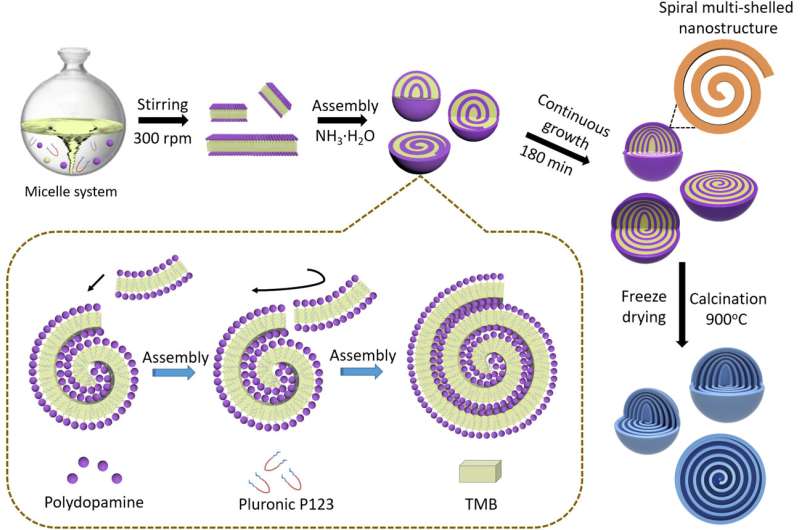
It is challenging to develop functional carbon nanospheres with well-defined porosity and complex multi-shelled nanostructures. In a new report now published in Science Advances, Liang Peng and a research team in chemistry and materials synthesis, in China, reported a lamellar micelle spiral self-assembly strategy to form multi-shelled mesoporous carbon nanospheres with unique chirality. In this method, the team introduced shearing flow to drive the spiral self-assembly. The resultant self-support spiral architecture of the multi-shelled carbon nanospheres in combination with their high surface area and abundant nitrogen content with plentiful mesopores yielded excellent electrochemical performance for potassium storage. The micelle-directed self-assembly offered a simple and powerful strategy to inspire nanostructure design of functional materials in the future.
Developing the micelle system
The team developed multi-shelled carbon nanospheres (MCNs) with unique chiral architecture, which involved the creation of a lamellar Pluronic trimethyl benzene (TMB)/dopamine (DA) micelle system driven by the shearing flow to control the polymerization of precursors and intelligently self-assemble into multi-shelled nanospheres. The lamellar micelles grew spirally and continuously to form a stable full sphere. The spiral MCNs delivered superior rate capability and long cycling stability when used as an anode material for potassium ion batteries. This strategy can open a multifunctional platform to construct a variety of nanostructures for applications. Peng et al. prepared the MCNs using a lamellar micelle spiral self-assembly strategy using the Pluronic platform as a soft template, TMB as the hydrophobic interaction mediation agent and dopamine as the nitrogen and carbon source in the ethanol/water mixture. At first, Peng et al. composed the lamellar micelles in the system by stirring at 300 rpm from reaction-evolution. They then dynamically assembled the composite micelles into the mesostructured polydopamine (PDA) nanospheres via shearing flow. The carbonization of the freeze-dried polydopamine nanospheres in nitrogen atmosphere led to the formation of spiral MCNs with interesting chiral architecture.
Materials characterization and development
The field-emission scanning electron microscopy (FESEM) images showed the mesostructured polydopamine nanospheres to be very uniform with an average particle size of 180 nm. Using transmission electron microscopy (TEM), the team imaged the polydopamine nanospheres to maintain a multi-shelled chiral hollow structure, which they retained without collapse and deformation after high-temperature calcination. Using magnified TEM images, the team clearly showed the growth of the multi-shelled architecture and confirmed the 3D multi-shelled nanostructure to show the typical amorphous phase of carbon framework with many structural defects. Using elemental maps, Peng et al. then showed the uniform distribution of carbon, nitrogen and oxygen atoms in each carbon shell. The results indicated a lamellar mesoporous structure of the materials, while small-angle X-ray scattering patterns showed a multi-shelled nanostructure. They then also studied the effect of solvent on the formation of the spiral MCNs (multi-shelled carbon nanospheres)—while the presence of ethanol helped form the structures, excess ethanol caused them to be labile. Furthermore, by increasing the mass ratio of the constituents, the scientists varied the structure of products from smooth solid nanospheres to triple-shelled constructs.
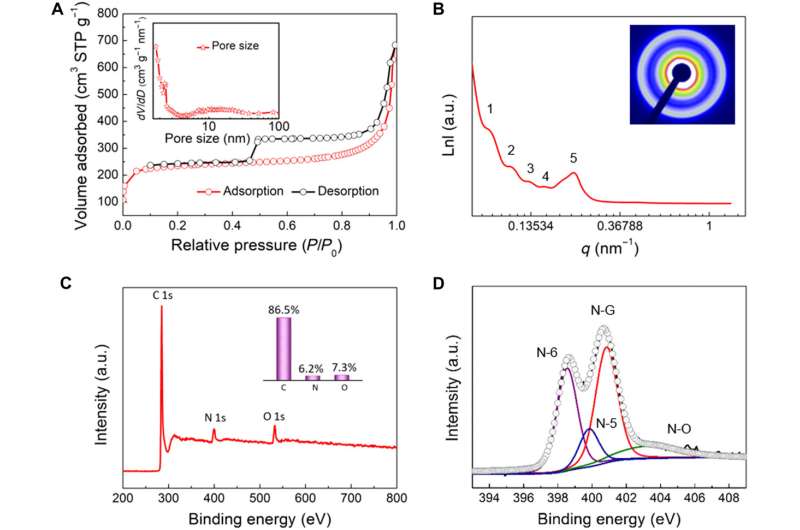
Morphology and structure of MCNs (multi-shelled carbon nanospheres)
The precursor amount and stirring rate also affected the morphology and mesostructure of MCNs in the reaction system. By increasing the amount of dopamine, Peng et al. tuned the structure of the obtained products from thin nano-disks to a mixture of single hollow and multi-shelled nanospheres. By increasing the dopamine, they further developed pure quintuple-shelled nanospheres with a fully developed chiral architecture. The results also highlighted agitation as a driving force for the self-assembly of multi-shelled nanostructures. The team regulated the morphology and mesostructure of the products by affecting the hydrophobic and hydrophilic ratio of the copolymer templates used during their development.
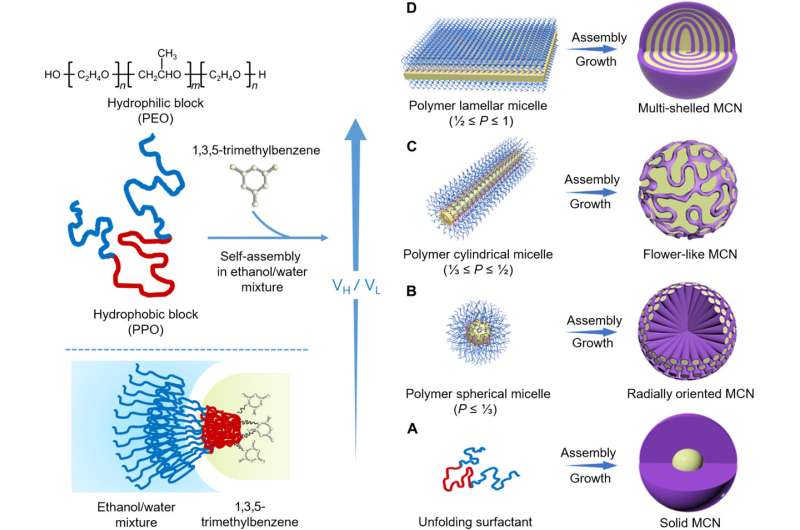
Electrochemical performance of the constructs and potassium ion batteries
To evaluate the electrochemical performance, Peng et al. first used cyclic voltammetry (CV) in the voltage scope of 0.01 to 3.0 V. Using TEM (transmission electron microscopy) images and nitrogen absorption isotherm analyses, the team showed how the multi-shelled mesoporous structure could be well maintained after a long-term cycle. At higher current densities, the advantages of the spiral multi-shelled constructs became more prominent. The MCNs presented an attractive rate capability and impressive cycling performance. To obtain further insights on the electrochemical behavior of the MCN electrode, Peng et al. conducted kinetics and quantitative analysis based on cyclic voltammetry tests at varying scan rates. The results revealed the gradual increase of the capacitive contribution ratio with the increase in scanning rate to demonstrate the advantages of the multi-shelled spiral structure.
-
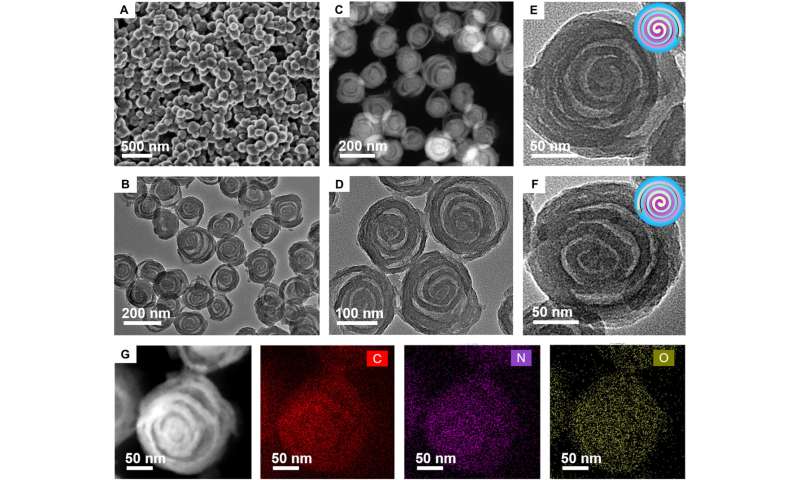
Microstructure characterization of the spiral MCNs. (A) FESEM image, (B and D) TEM image, (E and F) magnified TEM images, and (C and G) scanning TEM and energy-dispersive x-ray element mapping images of the mesoporous MCNs with unique chiral architecture prepared by the lamellar micelle spiral self-assembly strategy. Credit: Science Advances, doi: 10.1126/sciadv.abi7403 -
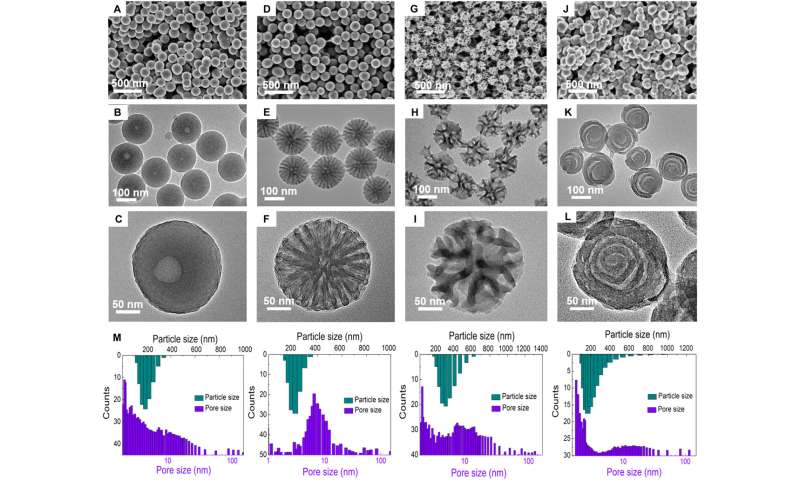
The controllability and versatility of the synthetic method. FESEM and TEM images of the mesoporous carbon nanospheres prepared by adjusting the interfacial curvature of micelles through using different Pluronic triblock copolymers: (A to C) F108, (D to F) F127, (G to I) P105, and (J to L) P123. (M) The corresponding distribution histograms of the particle diameters and pore sizes. Credit: Science Advances, doi: 10.1126/sciadv.abi7403
Outlook
In this way, Liang Peng and colleagues directly created multi-shelled carbon structures using block copolymer self-assembly and rationally regulated the micelle structure by introducing appropriate mediation agents to balance the outcome. They developed uniform multi-shelled carbon nanospheres with well-defined porosity and unique architecture based on a lamellar micelle spiral self-assembly approach. The approach featured the introduction of shearing flow to drive the lamellar micelles continuously to self-assemble into stable multi-shelled nanospheres. The micellar structure can be systematically tuned by regulating the ratio of surfactants to create flower-like and multi-shelled nanospheres. The resulting MCNs delivered excellent rate capability, unprecedented chiral architecture, and long-term cyclic stability for potassium ion batteries. The work represents a multifunctional platform to synthesize novel nanostructures for advanced applications, alongside foundational information on micelle-directed self-assembly and chemistry.
More information: Liang Peng et al, Spiral self-assembly of lamellar micelles into multi-shelled hollow nanospheres with unique chiral architecture, Science Advances (2021). DOI: 10.1126/sciadv.abi7403
Jian Liu et al, Molecular-based design and emerging applications of nanoporous carbon spheres, Nature Materials (2015). DOI: 10.1038/nmat4317
Journal information: Science Advances , Nature Materials
© 2021 Science X Network





















